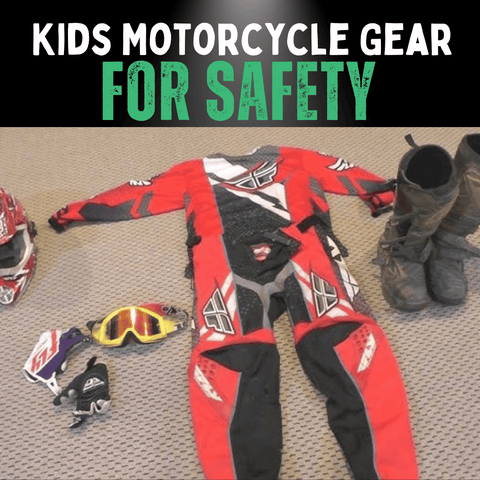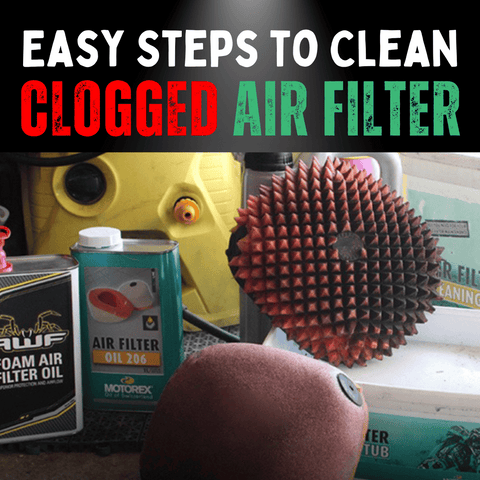
Embarking on the dirt biking journey with your teen can be as thrilling as it is daunting.
If you've found yourself here, it's likely because you're seeking guidance on how to maintain your teen's dirt bike safely and efficiently.
You're in the right place. Many parents face the challenge of keeping their teen's dirt bike in top condition, all the while ensuring their safety and fostering their growing passion for this exhilarating sport.
It's a fine balance between encouraging independence and ensuring they're equipped with the knowledge to ride responsibly.
The Importance of Maintenance
The key to maximising the thrill and safety of dirt biking lies in regular maintenance.
A well-maintained bike ensures optimal performance, safeguards the rider, and prolongs the lifespan of the bike itself.
It teaches teens the importance of care and attention to detail—lessons that are invaluable both on and off the trail.
Parental Role
Your involvement in your teen's dirt biking journey is crucial.
Beyond just supervising, you're there to guide, educate, and sometimes, learn alongside them.
It's a chance to instil a sense of responsibility, enhance mechanical knowledge, and strengthen your bond through shared activities.
Safety Equipment
Essential Gear
Before we get into the grease and gears, let's talk safety. Essential gear such as helmets, goggles, gloves, boots, and protective clothing is non-negotiable.
This gear acts as the first line of defence against potential injuries, ensuring that your teen enjoys the sport with the utmost safety.
Gear Maintenance
But having the gear isn't enough. Regular inspection for wear and tear is crucial to maintain its protective integrity.
Teach your teen to examine their safety equipment for any signs of damage before every ride, making it a routine part of their pre-ride checklist.
Cleaning and Washing
Significance of Cleanliness
A clean bike is a happy bike. Regular cleaning not only keeps the bike looking great but also prevents the buildup of dirt and debris, which can lead to premature wear and tear on parts.
It's an essential step in maintenance that also offers the perfect opportunity to inspect the bike for any issues.
Cleaning Steps
Cleaning your teen's dirt bike is not just about keeping it looking good—it's a crucial maintenance step that ensures the bike performs at its best and lasts longer.
Here's a detailed guide to effectively cleaning the bike, designed to make this task both efficient and thorough.
Step 1: Preparing the Bike
Start by placing the bike on a stand to ensure stability and ease of access to all parts.
If you don't have a stand, make sure it's securely positioned to prevent any accidental tipping.
Remove any loose items or accessories that could obstruct the cleaning process or potentially get damaged by water.
Step 2: Initial Rinse
Using a garden hose, gently rinse the bike to remove loose dirt and mud.
This initial rinse helps to prevent scratching the bike's surface when you start scrubbing.
Avoid using high-pressure washers, as the forceful water can penetrate bearings, seals, and other sensitive components, leading to potential damage.
Step 3: Applying Cleaner
Once the loose dirt is rinsed off, apply a mild detergent or a bike-specific cleaning solution.
These specialised cleaners are designed to break down dirt and grease without harming the bike's paint or mechanical parts.
Apply the cleaner with a spray bottle or a soft sponge, covering all surfaces but paying particular attention to areas with caked-on dirt.
Step 4: Scrubbing the Bike
With the cleaning solution applied, use soft brushes or microfiber cloths to gently scrub the bike.
Different sizes of brushes can be used to effectively clean hard-to-reach areas, like the spaces between spokes or under the seat.
Be thorough but gentle, especially on painted surfaces to avoid scratches.
For the chain and sprockets, consider using a brush specifically designed for these components to remove built-up grime and old lubricant.
Step 5: Detailed Cleaning
Pay special attention to areas where dirt and grease accumulate, such as the engine area, undercarriage, and suspension components.
These areas may require additional scrubbing and possibly a second application of the cleaning solution.
Use a smaller brush or an old toothbrush to get into tight spaces and dislodge stubborn dirt.
Step 6: Final Rinse
After thoroughly scrubbing the bike, rinse it off with a gentle flow of water.
Ensure all soap and cleaning agents are washed away, as residue can attract dirt or degrade the bike's surfaces over time.
Again, be mindful of the water pressure and direction to avoid damaging sensitive areas.
Step 7: Drying
Drying the bike is as important as the cleaning itself to prevent rust and water spots.
Use a clean, soft cloth or chamois to gently dry the surfaces.
Start from the top and work your way down, ensuring that all parts are thoroughly dried.
Pay extra attention to areas where water might collect, such as under the seat, around the engine, and inside the wheel hubs.
Step 8: Final Inspection
Once the bike is dry, take a moment to inspect the bike for any signs of wear or damage that might have been obscured by dirt.
This is also an excellent time to check for loose bolts or parts that may need attention.
By following these detailed cleaning steps, you not only keep your teen's dirt bike looking great but also contribute significantly to its maintenance and longevity.
Regular cleaning allows you to become familiar with the bike's condition, making it easier to spot potential issues before they become serious problems.
Inspection and Lubrication
Pre-Ride Inspection
A thorough pre-ride inspection can prevent many issues from arising during a ride.
Teach your teen to check the tyres, brakes, chains, and sprockets for any signs of wear or damage.
This proactive approach ensures the bike is safe and ride-ready.
Tyre Inspection
Tyre condition is critical for safe and efficient riding. Show your teen how to check for proper inflation, tread wear, and any damage that might compromise safety or performance.
Brake System Inspection
Brakes are your teen's best friend on the trail, providing control and safety.
Regular checks of the brake pads, discs, and fluid levels are essential to ensure the bike can stop effectively when needed.
Checklist
Creating a simple checklist for pre-ride inspections can instil good habits and ensure nothing is overlooked.
Include checks for tire pressure, brake functionality, chain tension, and any loose or damaged parts.
Lubrication Guidance
Proper lubrication reduces wear and ensures the smooth operation of the bike's components.
Educate your teen on the importance of using the right lubricants for the chain, cables, and moving parts, and show them how to apply it correctly.
| Checklist Item | Description |
|---|---|
| Tyre Condition | Check for proper inflation, tread wear, and any visible damage. |
| Brake System | Inspect brake pads for wear, check brake fluid levels, and test responsiveness. |
| Chain and Sprockets | Ensure the chain is properly tensioned and lubricated, and sprockets are not worn out. |
| Suspension | Verify the suspension settings are appropriate for the rider's weight and riding conditions. |
| Fluid Levels | Check oil, coolant, and brake fluid levels are within recommended ranges. |
| Lights and Signals (if applicable) | Ensure all lights and signals are functional. |
Oil and Fluid Check
Role of Oil
Oil and other fluids play a vital role in the smooth operation and longevity of the bike's engine and systems.
They reduce friction, cool components, and prevent wear.
Checking Procedures
Teach your teen the importance of regularly checking oil, coolant, and brake fluid levels.
Show them how to top up these fluids and explain the signs that indicate when a change is needed.
Oil Changes
Regular oil changes are a cornerstone of good bike maintenance.
Guide your teen through the process, emphasising the importance of using the right type of oil and following safe procedures.
Air Filter Maintenance
Air Filter Importance
A clean air filter is crucial for optimal engine performance. Dirt and debris can choke the engine, reducing power and efficiency.
Regular cleaning and replacement of the air filter keep the engine running smoothly.
Maintenance Steps
Show your teen how to remove, clean, and re-oil the air filter.
This simple task can have a significant impact on the bike's performance and is a great way to introduce them to engine maintenance.
Spark Plug Inspection and Replacement
Spark Plug Role
The spark plug is a small but essential component of the engine, providing the spark that ignites the fuel.
A dirty or worn spark plug can lead to starting difficulties and poor engine performance.
Inspection Process
Inspecting the spark plug for signs of wear or fouling is a simple yet important maintenance task.
Teach your teen how to check the spark plug and recognise when it needs to be replaced.
Replacement Guide
Replacing a spark plug is a basic but critical maintenance skill.
Ensure your teen knows how to safely remove and install a spark plug, emphasising the importance of the correct torque and gap settings.
Battery Maintenance
Battery Importance
For electric start bikes, a healthy battery is essential for reliable starting.
It also powers the bike's electrical systems, making its maintenance a key part of overall bike care.
Maintenance Tips
Educate your teen on checking the battery's charge level, cleaning terminals to prevent corrosion, and the proper storage methods during periods of inactivity to extend the battery's life.
Suspension Adjustment
Suspension Basics
The suspension system affects the bike's handling and comfort.
Understanding how to adjust preload, compression, and rebound settings can greatly enhance the riding experience, making it tailored to the rider's weight, style, and terrain.
Adjustment Instructions
Guide your teen through the process of adjusting the suspension, emphasising the effects of each adjustment and how to test and refine settings for the best ride quality.
Conclusion
Maintenance Recap
Dirt bike maintenance is not just about keeping the bike in good running condition; it's a comprehensive approach to safety, performance, and longevity.
It's a valuable learning opportunity for your teen, instilling a sense of responsibility and pride in their riding and care for their bike.
Parental Involvement
Your involvement in this process is invaluable. By taking the time to teach your teen about bike maintenance, you're not only ensuring their safety on the trails but also strengthening your relationship through shared experiences and learning.
Safety Reminder
Lastly, always prioritise safety. While it's empowering to handle many maintenance tasks at home, recognise when professional help is needed.
Encouraging your teen to seek expert advice or service when necessary reinforces the importance of safety and proper care.
By embracing the journey of dirt bike maintenance together, you're not just ensuring the mechanical wellness of a bike; you're nurturing a well-rounded, responsible, and skilled young rider.
Get in Touch 🚀
Loved our article on “Here's the Basic Maintenance of Your Dirt Bike?” Got the itch to dive into more wheely-awesome info?
Whether you're a parent or a grandparent, we're here for all your kids ride-on toy questions! 🚗💨
Feeling click-happy?
Jump straight into our wonderland at RiiRoo.com.
Or, if you're more the chatty type, give our Live Chat a whirl and let's talk toys!








Share:
Why Does My Dirt Bike Have Reduced Engine Power?
How to Install A Fuel Filter on Your Dirt Bike